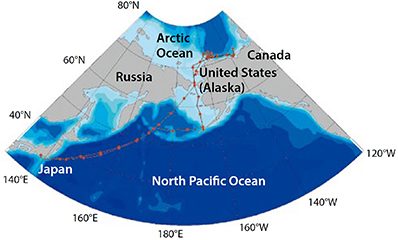Continuity and Challenge – FY2022 R/V Mirai Arctic Cruise
*This article was originally published in ArCS II News Letter No.6 (Feb. 2023).
| The 2022 Arctic cruise was conducted aboard oceanographic research vessel MIRAI (R/V Mirai, JAMSTEC) with Dr. Motoyo Itoh as Chief Scientist under the ArCS II projects. She talked about the 49-day Arctic research and gave a fascinating insight into the R/V Mirai cruise. She says that a chief scientist is one who manages the scientific requirements of a cruise for all members of the scientific party and maximizes the performance of R/V Mirai within the limited ship time. (Interviewer: ArCS II Secretariat) |  |
 |
| Dr. Motoyo Itoh |

A beautiful view off the Alaskan coast from R/V Mirai on September 9, 2022.

──What is the objective of the R/V Mirai cruise?
The warming in the Pacific Arctic Ocean which is the target area of R/V Mirai’s research has been much faster than in the rest of the world. To understand rapid ocean climate changes and evaluate the effect on the environment, it is essential to continue the research observation. R/V Mirai has collected data for 20 years in the Pacific Arctic Ocean even under the COVID-19 pandemic. We focus on specific research themes and/or areas for each cruise.
We performed the surveys in the Canadian Arctic waters in 20 years. In the Mackenzie area, the air temperature went over 11˚C. I have never experienced such a warm weather before and felt that the Arctic environment is enormously changing in the past 20 years. The warm river water with nearly 10˚C extended more than 200 km offshore from the mouth of the Mackenzie River and melted the sea ice there. The hydrographic features are quite different from that in the western side of the Pacific Arctic Ocean where we continued the surveys by R/V Mirai. Simulation results by ArCS II researchers revealed that river water is a trigger for the sea ice melting and air temperature rise (Park, Watanabe, et al., 2020, Science Advances). Similarly, the impact of river water on the sea ice melting will be a notable research topic in the Canadian Arctic waters.

In addition, as a part of HAPPI (Holocene Arctic Palaeoclimatology and Palaeoceanography Investigation), over 70 sediment cores were obtained from the seabed using mud samplers in the Mackenzie and Barrow areas. Through future analysis, this project documents paleoceanographic, climatic, and environmental
changes over the last 2,000 years to better understand both the natural and anthropogenic factors that contribute to the Arctic environment.
Trials of an under-ice drone COMAI (Challenge of Observation and Measurement under Arctic Ice) are also conducted. COMAI successfully took movies and measured water temperature, salinity, and other parameters under the sea ice. We are also challenging an automated cruise in the polar region where errors of magnetic compass are large. The practical application of COMAI is expected to open up new possibilities, such as environmental surveys just below sea ice where data collection is difficult from the ship.
Yes. Japan has collaborated with the United States, Canada, South Korea, and other countries under the Pacific Arctic Group (PAG). We also have collaborated in the Synoptic Arctic Survey (SAS) project for the entire Arctic Ocean including the Atlantic side of the Arctic Ocean from 2020 to 2022. Despite the vastness of the Arctic Ocean, in-situ observations by ship are limited to the summer and fall months, so it is more efficient to collect data under the international collaboration among many countries rather than one country.
During this year’s cruise, I communicated with the chief scientist of the U.S. research vessel, and we coordinated the stations not to overlap in location and timing. International collaboration is very active in the Arctic Ocean research.
Foreign researchers participated in FY2022 R/V Mirai cruise for the first time since the COVID-19 pandemic. During the cruise, there are many opportunities to communicate with researchers who have different research fields, nationalities, and generations, which can lead to new collaborative research.
──What was the most challenging experience during the cruise?The cruise had to be shortened by one week due to high oil prices, and ship time was not enough to achieve all activities that we originally planned. In order to get the maximum effort even if severe weather and ice conditions, we needed to revise the cruise plan based on the latest weather and ice forecasts almost every day. It was a highly successful expedition with the support of experienced Ice Navigator D. Snider and Captain H. Inoue of R/V Mirai.
──What is an outstanding point of R/V Mirai?In terms of facilities, R/V Mirai is an excellent platform for integrated multidisciplinary ocean science that is equipped with meteorological, oceanographical, and geological research facilities. In addition, R/V Mirai can be navigated even in bad weather conditions, because it is one of the largest oceanographic research vessels in the world. However, the most outstanding aspect is the experienced staff who supports the Arctic cruise. The cruise would not have succeeded without the diligent work of the crew, officers, ice navigator, captain, and technicians of R/V Mirai. Support from the shore, such as navigational assistance and information dissemination, is also essential. We greatly appreciate all people who support the R/V Mirai cruise.
──How does FY2022 R/V Mirai cruise contribute to developing the future research?Hydrographic observations in the Mackenzie area will provide insight into the effects of river water on sea ice melting. JAMSTEC and collaborators are acquiring hydrographic and geochemical data at repeat stations spanning the region including Canadian Arctic water. The data from this program will be used to study the changes in physical, geochemical, and biological components of sea water since 1998 when the R/V Mirai Arctic cruise began.

